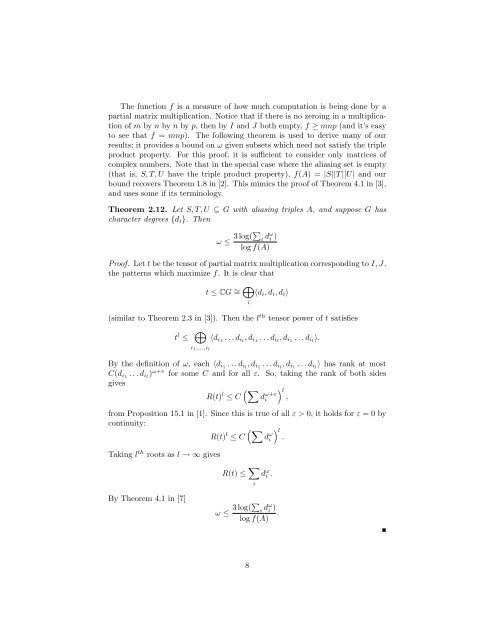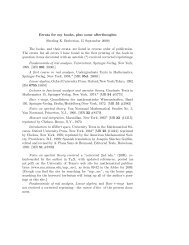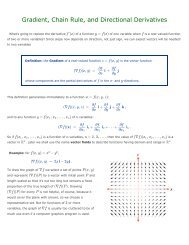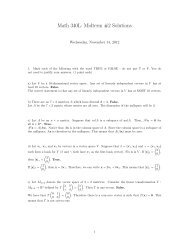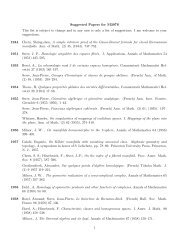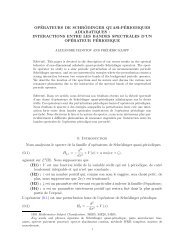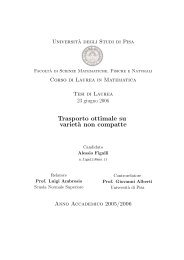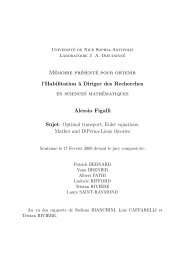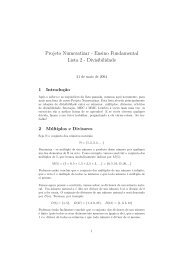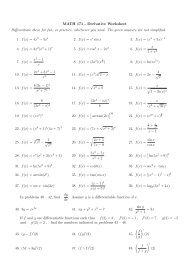Group-Theoretic Partial Matrix Multiplication - Department of ...
Group-Theoretic Partial Matrix Multiplication - Department of ...
Group-Theoretic Partial Matrix Multiplication - Department of ...
Create successful ePaper yourself
Turn your PDF publications into a flip-book with our unique Google optimized e-Paper software.
The function f is a measure <strong>of</strong> how much computation is being done by a<br />
partial matrix multiplication. Notice that if there is no zeroing in a multiplication<br />
<strong>of</strong> m by n by n by p, then by I and J both empty, f ≥ mnp (and it’s easy<br />
to see that f = mnp). The following theorem is used to derive many <strong>of</strong> our<br />
results; it provides a bound on ω given subsets which need not satisfy the triple<br />
product property. For this pro<strong>of</strong>, it is sufficient to consider only matrices <strong>of</strong><br />
complex numbers. Note that in the special case where the aliasing set is empty<br />
(that is, S, T, U have the triple product property), f(A) = |S||T ||U| and our<br />
bound recovers Theorem 1.8 in [2]. This mimics the pro<strong>of</strong> <strong>of</strong> Theorem 4.1 in [3],<br />
and uses some if its terminology.<br />
Theorem 2.12. Let S, T, U ⊆ G with aliasing triples A, and suppose G has<br />
character degrees {di}. Then<br />
ω ≤<br />
3 log(<br />
i dω i )<br />
log f(A)<br />
Pro<strong>of</strong>. Let t be the tensor <strong>of</strong> partial matrix multiplication corresponding to I, J,<br />
the patterns which maximize f. It is clear that<br />
t ≤ CG ∼ <br />
= 〈di, di, di〉<br />
(similar to Theorem 2.3 in [3]). Then the lth tensor power <strong>of</strong> t satisfies<br />
t l ≤ <br />
〈di1 . . . dil , di1 . . . dil , di1 . . . dil 〉.<br />
i1,...,il<br />
By the definition <strong>of</strong> ω, each 〈di1 . . . dil , di1 . . . dil , di1 . . . dil 〉 has rank at most<br />
C(di1 . . . dil )ω+ε for some C and for all ε. So, taking the rank <strong>of</strong> both sides<br />
gives<br />
R(t) l ≤ C<br />
i<br />
l ω+ε<br />
di ,<br />
from Proposition 15.1 in [1]. Since this is true <strong>of</strong> all ε > 0, it holds for ε = 0 by<br />
continuity:<br />
R(t) l l ω<br />
≤ C di .<br />
Taking l th roots as l → ∞ gives<br />
By Theorem 4.1 in [7]<br />
R(t) ≤ <br />
i<br />
d ω i .<br />
3 log(<br />
ω ≤<br />
log f(A)<br />
8<br />
i dω i )<br />
.


